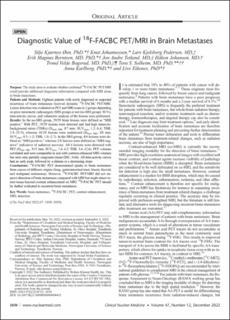| dc.description.abstract | Purpose
The study aims to evaluate whether combined 18F-FACBC PET/MRI could provide additional diagnostic information compared with MRI alone in brain metastases.
Patients and Methods
Eighteen patients with newly diagnosed or suspected recurrence of brain metastases received dynamic 18F-FACBC PET/MRI. Lesion detection was evaluated on PET and MRI scans in 2 groups depending on prior stereotactic radiosurgery (SRS group) or not (no-SRS group). SUVs, time-activity curves, and volumetric analyses of the lesions were performed.
Results
In the no-SRS group, 29/29 brain lesions were defined as “MRI positive.” With PET, 19/29 lesions were detected and had high tumor-to-background ratios (TBRs) (Dmax MR, ≥7 mm; SUVmax, 1.2–8.4; TBR, 3.9–25.9), whereas 10/29 lesions were undetected (Dmax MR, ≤8 mm; SUVmax, 0.3–1.2; TBR, 1.0–2.7). In the SRS group, 4/6 lesions were defined as “MRI positive,” whereas 2/6 lesions were defined as “MRI negative” indicative of radiation necrosis. All 6 lesions were detected with PET (Dmax MR, ≥15 mm; SUVmax, 1.4–4.2; TBR, 3.6–12.6). PET volumes correlated and were comparable in size with contrast-enhanced MRI volumes but were only partially congruent (mean DSC, 0.66). All time-activity curves had an early peak, followed by a plateau or a decreasing slope.
Conclusions
18F-FACBC PET demonstrated uptake in brain metastases from cancer of different origins (lung, gastrointestinal tract, breast, thyroid, and malignant melanoma). However, 18F-FACBC PET/MRI did not improve detection of brain metastases compared with MRI but might detect tumor tissue beyond contrast enhancement on MRI. 18F-FACBC PET should be further evaluated in recurrent brain metastases. | en_US |

